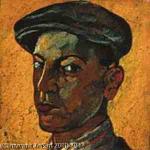אמן
עבודת אומנות
Languages
אינטראקציה
דף הבית Lajos Vajda
Lajos Vajda

מקום: Zalaegerszeg
נוֹלָד: 1908
מָוֶת: 1941
בִּיוֹגְרַפִיָה:
Lajos Vajda (Hungarian: Vajda Lajos 1908, Zalaegerszeg – 1941, Budakeszi) was a Hungarian painter. He was a student of István Csók at the Hungarian Academy of Fine Arts in 1927-30. He studied together with Dezsõ Korniss at Fernand Léger in Paris in 1930-34 where he was introduced to cubism and surrealism. He lived and worked in Szentendre, Hungary....
Wikipedia link: Click Here